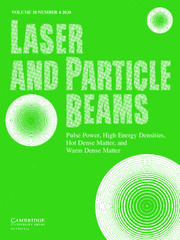Article contents
Studies of ablated plasma and shocks produced in a planar target by a sub-nanosecond laser pulse of intensity relevant to shock ignition
Published online by Cambridge University Press: 09 July 2015
Abstract
The effect of laser intensity on characteristics of the plasma ablated from a low-Z (CH) planar target irradiated by a 250 ps, 0.438 µm laser pulse with the intensity of up to 1016 W/cm2 as well as on parameters of the laser-driven shock generated in the target for various scale-lengths of preformed plasma was investigated at the kilojoule Prague Asterix Laser System (PALS) laser facility. Characteristics of the plasma were measured with the use of 3-frame interferometry, ion diagnostics, an X-ray spectrometer, and Kα imaging. Parameters of the shock generated in a Cl doped CH target by the intense 3ω laser pulse were inferred by numerical hydrodynamic simulations from the measurements of craters produced by the shock in the massive Cu target behind the CH layer. It was found that the pressure of the shock generated in the plastic layer is relatively weakly influenced by the preplasma (the pressure drop due to the preplasma presence is ~10–20%) and at the pulse intensity of ~1016 W/cm2 the maximum pressure reaches ~80–90 Mbar. However, an increase in pressure of the shock with the laser intensity is slower than predicted by theory for a planar shock and the maximum pressure achieved in the experiment is by a factor of ~2 lower than predicted by the theory. Both at the preplasma absence and presence, the laser-to-hot electrons energy conversion efficiency is small, ~1% or below, and the influence of hot electrons on the generated shock is expected to be weak.
- Type
- Research Article
- Information
- Copyright
- Copyright © Cambridge University Press 2015
References
REFERENCES
- 8
- Cited by




